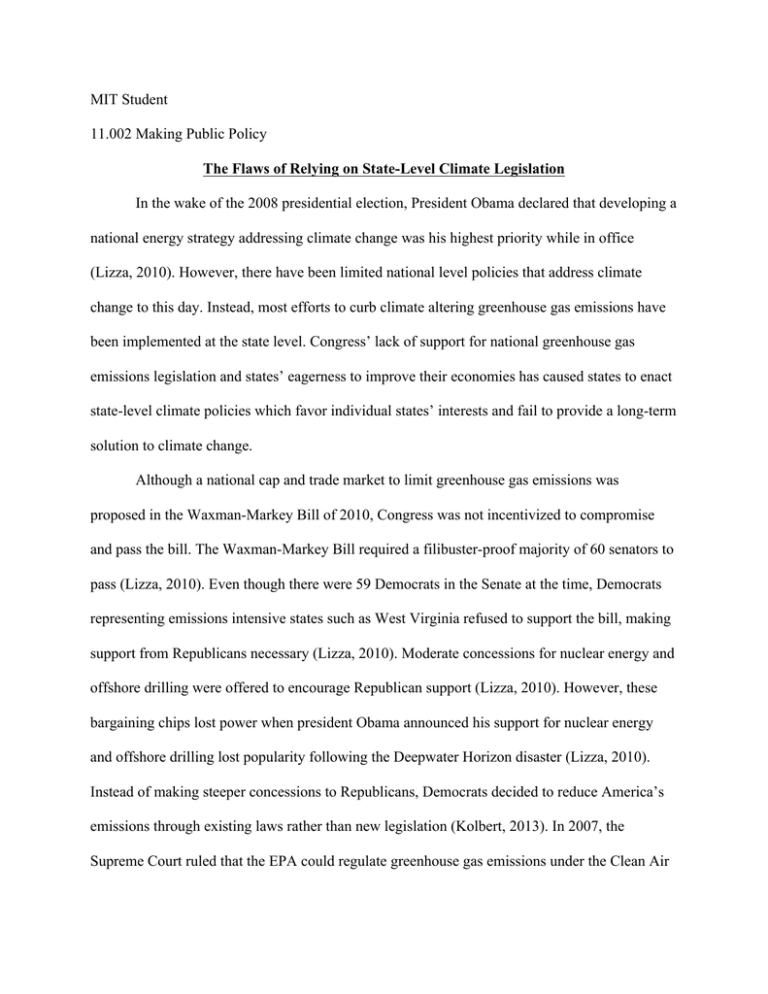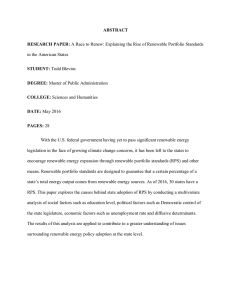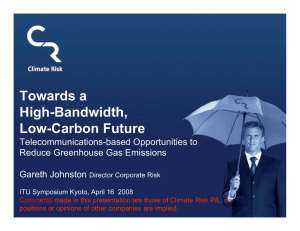MIT Student 11.002 Making Public Policy
advertisement

MIT Student 11.002 Making Public Policy The Flaws of Relying on State-Level Climate Legislation In the wake of the 2008 presidential election, President Obama declared that developing a national energy strategy addressing climate change was his highest priority while in office (Lizza, 2010). However, there have been limited national level policies that address climate change to this day. Instead, most efforts to curb climate altering greenhouse gas emissions have been implemented at the state level. Congress’ lack of support for national greenhouse gas emissions legislation and states’ eagerness to improve their economies has caused states to enact state-level climate policies which favor individual states’ interests and fail to provide a long-term solution to climate change. Although a national cap and trade market to limit greenhouse gas emissions was proposed in the Waxman-Markey Bill of 2010, Congress was not incentivized to compromise and pass the bill. The Waxman-Markey Bill required a filibuster-proof majority of 60 senators to pass (Lizza, 2010). Even though there were 59 Democrats in the Senate at the time, Democrats representing emissions intensive states such as West Virginia refused to support the bill, making support from Republicans necessary (Lizza, 2010). Moderate concessions for nuclear energy and offshore drilling were offered to encourage Republican support (Lizza, 2010). However, these bargaining chips lost power when president Obama announced his support for nuclear energy and offshore drilling lost popularity following the Deepwater Horizon disaster (Lizza, 2010). Instead of making steeper concessions to Republicans, Democrats decided to reduce America’s emissions through existing laws rather than new legislation (Kolbert, 2013). In 2007, the Supreme Court ruled that the EPA could regulate greenhouse gas emissions under the Clean Air Act if the emissions “endangered public health or welfare” and the polluter was a large point source that already needed EPA permits (Liptak, 2014, p. 4). After the failure of the WaxmanMarkey Bill, Obama exercised this power and set emissions reduction targets for each state; however, states would determine how to achieve those targets themselves (Davenport & Baker, 2014). When Obama ordered states to reduce emissions in 2014, many states already had carbon reduction plans in place to promote an in-state renewable energy industry and improve their economy. Beginning in 1999, states enacted renewable portfolio standards (RPS) that required utilities operating in the state to purchase a portion of their energy from renewable sources (Rabe, 2007). These state-by-state RPS were easier to pass than national emissions legislation because state legislators could tailor legislation to benefit the state’s economic interests. For example, Republican dominated Texas passed RPS to attract new renewable energy industries to the state and spur economic growth – environmental benefits were just a by-product (Rabe, 2007). Other states with considerable fossil fuel resources such as Pennsylvania have historically opposed national renewable energy efforts in Congress (Rabe, 2007); however, Pennsylvania’s legislature voluntarily enacted RPS in 2004 because the policy gave preference to in-state renewable energy companies that would employ displaced manufacturing workers (Rabe, 2007). On the other hand, energy importing states such as California or Massachusetts passed RPS to harness in-state renewable resources that would reduce spending on energy produced out-of-state (Gillis & Wines, 2014). Although not all states were eager to pass RPS, Obama’s emissions targets announcement spurred additional states to voluntarily pass emissions reduction policies. States knew that a plan drafted by their own state legislature would be an easier way to achieve targets than following an EPA mandated plan (Davenport & Baker, 2014). Since states drafted their own emissions reduction plans to comply with national targets, they enacted policies that benefitted their own state’s interests at the expense of national and environmental interests. For example, Pennsylvania’s RPS was designed to encourage in-state job creation without destroying existing coal jobs. Pennsylvania’s RPS counted new coal based fuels such as coal wastes, coal gasification, and coal bed methane as “alternative energy sources” despite high carbon emissions (Rabe, 2007, p. 14). Similarly, Maine’s RPS classified large scale hydro as renewable despite many environmental drawbacks because the state had large scale hydro potential that could satisfy targets cheaply (Barnes & Barnes, 2013). Without a national classification standard for renewable energy, states will alter the definition of renewable energy to comply with EPA targets at minimal cost. Another tactic states use to benefit their own economy is requiring a portion of renewable energy to be generated in-state. This can be implemented through a clause in the states’ RPS or enacting a net metering law, which allows renewable energy generated in the state to be sold to the local utility for a fixed rate. Although in-state generation guarantees in-state jobs, it can force renewable generation to be constructed in states with suboptimal renewable resources (Rabe, 2007). The EPA has attempted to prevent this inefficient distribution of renewable generation by setting targets that reflect “what each [state] could practically achieve without causing economic harm” (Davenport & Baker, 2014, p. 4). States with renewable resources that are easy to harness would be given higher targets to ensure those resources are developed first. However, the EPA still cannot create an ideal distribution of renewable resource development because its targets are set by policymakers and not market equilibrium (Cardwell, 2014). To ensure renewable resources are optimally harnessed, a national market for trading renewable energy credits will be needed (Rabe, 2007). This market would allows states producing more low-cost renewable energy than mandated at a low price to sell it to other states that cannot meet their target economically (Rabe, 2007). While state level climate policies may reduce emissions in the short run, national policies will be needed to produce lasting significant impacts on climate change. The current system of allowing states to write emissions plans that meet EPA targets fails to produce a lasting impact because the EPA’s authority is contingent on the current president’s willingness to regulate states (Davenport & Baker, 2014). If a Republican becomes president in the next election cycle, he or she would likely loosen emissions targets and condone ineffective state plans. Without oversight, coal dependent states such as Indiana would scale back their RPS from a mandatory reduction in emissions to a recommended reduction (Cardwell, 2014). Regulations that change every presidential election cycle would deter long term investments in renewable energy (Johnson, 2014). These long term investors are crucial for large scale projects that will lower the price of renewable energy (Johnson, 2014). While state level climate policies encourage renewable energy production, they ignore the need to expand interstate transmission, backup generation, and storage capacity necessary for accommodating growth in renewable generation (Barnes & Barnes, 2013). These grid upkeep costs currently account for 55% of the price of utility supplied electricity and the costs are expected to rise as intermittent renewable sources make up a larger share of power generation – forcing utilities to raise rates (Schwartz, 2014). Net metering laws have exacerbated this problem by allowing homeowners with renewable generation to buy and sell electricity to the grid without drawing net electricity from the grid (Schwartz, 2014). Thus, net metering has allowed renewable energy producers to send energy through the grid without paying the utility for grid maintenance (Schwartz, 2014). Utilities in Arizona have attempted to charge renewable energy producers a fixed fee for using the grid, but solar advocates argue that the added cost would halt growth in rooftop solar capacity (Randazzo & Anglen, 2013). Lastly, state climate policies are unable to make international climate treaties that are necessary for long term impacts on climate. Stabilizing earth’s climate with an 80% reduction in worldwide emissions by 2050 would be impossible without negotiating with other nations because the US only contributes to 25% of worldwide emissions (Victor, 2004). Congress’ failure to compromise on national emissions reduction legislation and states’ ambition to revive their economies with a renewable energy industry has caused most of America’s climate legislation to be enacted by states and regulated by the EPA. However, the policies passed by states favor states’ interests over national interests and fail to provide long range solutions to climate change. In the next five years, states will likely remain as the dominant source of climate legislation because Congress has gained conservative members since the 2010 attempt to pass Waxman-Markey. However, the targets states must comply with may change drastically depending on the President who is directing the EPA (Davenport & Baker, 2014). While the EPA can change states’ emissions targets, these targets will be relatively easy and inexpensive to achieve in the next few years because there are many inefficient power plants ready for retirement (Gillis & Wines, 2014). With natural gas prices that are currently lower than coal prices, utilities can economically retire old coal plants and build natural gas plants that emit half as much CO2 (Gillis & Wines, 2014). Once all coal plants have been replaced, lowering emission targets further will significantly affect energy prices and face a stronger backlash from energy users. References Barnes, J., & Barnes, C. (2013, Nov/Dec). 2013 RPS Legislation: Gauging!the Impacts. Solar Today pp. 16I 19. Cardwell, D. (2014, May 28). Pushback o Green!Power. New York Times pp. 1I4. Davenport, C., & Baker, P. (2014, June 2). Taking Page from Health Care Act, Obama Climate Plan Relies o States. New York Times pp. 1I4. Gillis, J., & Wines, M. (2014, June 6). In Some States, Emissions Cuts Defy Skeptics. The New York Times, pp. 1I5. Johnson, M. (2014, Jan 25). Why is renewable energy so expensive? The Economist. Kolbert, E. (2013, June 25). Power Politics: Obama's Overdue ClimateIChange Speech. The New Yorker, pp. 1I3. Liptak, A. (2014, June 23). Justices Uphold Emissions Limts on Big!Industry. The New York Times pp. 1I5. Lizza, R. (2010, Oct 11). As the World Burns. The New Yorker. Rabe, B. (2007). Race to!the Top: The Expanding Role of US State Renewable Portfolio!Standards. Sustainable&Development Law & Policy 10I16. Randazzo, R., & Anglen, R. (2013, December 21). APS, solar companies clash!over credits to!customers. The Rpublic pp. 1I5. Schwartz, J. (2014, Jan 25). Fissures in GOP!as Some!Conservatives Embrace!Renewable!Energy. New York Times pp. 1I4. Victor, D. G. (2004). Climate Change: Debating America's Policy Options. Council Policy Initiative 1I8. MIT OpenCourseWare http://ocw.mit.edu 11.002J / 17.30J Making Public Policy Fall 2014 For information about citing these materials or our Terms of Use, visit: http://ocw.mit.edu/terms.







